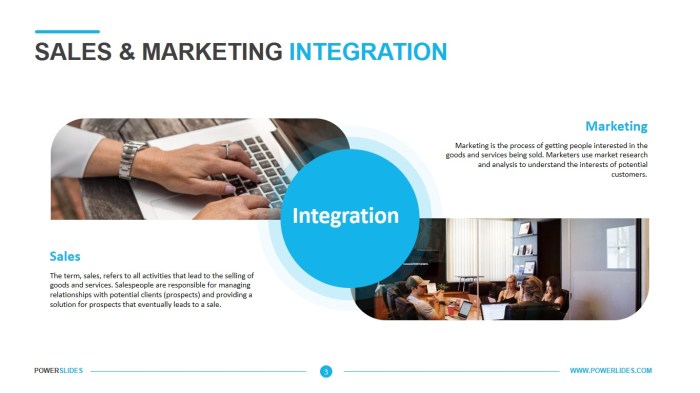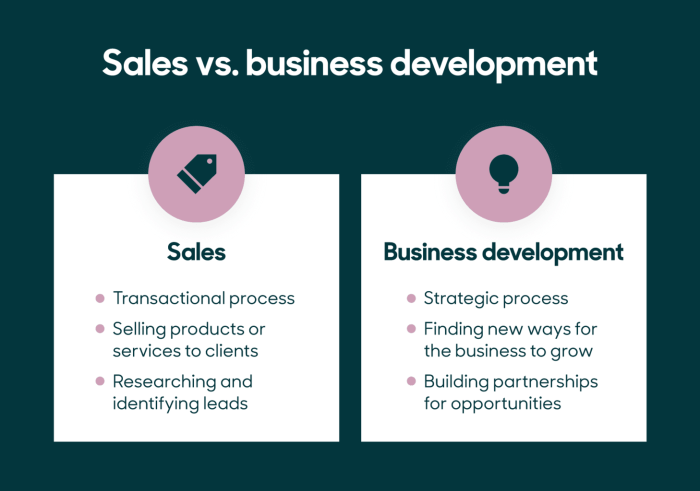
Seamlessly aligning sales and business development functions is crucial for sustained growth. This exploration delves into the synergistic relationship between these two vital areas, examining how effective integration can unlock unprecedented opportunities for businesses of all sizes. We’ll uncover strategies to overcome potential conflicts, establish clear metrics for success, and leverage technology to streamline workflows. Prepare to discover how a cohesive approach can dramatically impact your bottom line.
From defining the distinct roles of sales and business development to implementing practical strategies for conflict resolution and performance measurement, this guide provides a comprehensive framework for achieving optimal integration. We’ll analyze real-world examples, explore the use of CRM systems and data analytics, and discuss the broader context of business development within a responsible and ethical framework.
Business Development

Business development encompasses a wide range of activities aimed at growing a company’s revenue and market share. It’s a multifaceted discipline requiring strategic thinking, strong interpersonal skills, and a deep understanding of the market landscape. Effective business development integrates various aspects of a business, from sales and marketing to operations and finance, to achieve sustainable growth.
The Role of Business Ethics in Business Development Strategies
Ethical considerations are paramount in successful business development. A strong ethical foundation fosters trust with clients, partners, and employees, leading to long-term relationships and a positive brand reputation. Unethical practices, on the other hand, can severely damage a company’s image and lead to legal repercussions. Integrating ethical considerations into every stage of the business development process – from market research to sales negotiations – ensures sustainable growth while upholding corporate social responsibility.
For example, a company prioritizing ethical sourcing and fair labor practices in its supply chain builds a stronger brand image and attracts customers who value ethical consumption.
Effective Business Coaching Techniques for Business Development Professionals
Business coaching plays a crucial role in enhancing the skills and performance of business development professionals. Effective coaching techniques often involve goal setting, performance feedback, and skill development through mentorship and training. For instance, a coach might use the GROW model (Goal, Reality, Options, Will) to guide a business development professional in identifying and achieving specific goals. Regular feedback sessions, focusing on both successes and areas for improvement, help professionals refine their approach and maximize their effectiveness.
Role-playing exercises and simulations can provide valuable experience in handling challenging sales situations and negotiations.
Comparison of Different Business Models and Their Implications for Business Development
Different business models, such as B2B (business-to-business), B2C (business-to-consumer), and subscription-based models, have distinct implications for business development strategies. A B2B model, for example, often requires a more relationship-focused approach, involving building strong connections with key decision-makers in target companies. In contrast, a B2C model might necessitate a broader marketing strategy focusing on brand awareness and customer acquisition through various channels.
Subscription-based models prioritize customer retention and recurring revenue streams, necessitating strategies focused on customer loyalty and satisfaction. The choice of business model significantly impacts the target audience, marketing channels, and sales processes employed in business development.
The Importance of Business Strategy in Achieving Long-Term Business Development Goals
A well-defined business strategy is the cornerstone of long-term business development success. It provides a roadmap for achieving specific goals, allocating resources effectively, and adapting to changing market conditions. A comprehensive business strategy should Artikel the company’s mission, vision, target market, competitive advantages, and key performance indicators (KPIs). Regular review and adaptation of the strategy are crucial to ensure its continued relevance and effectiveness in a dynamic business environment.
For example, a company aiming for market leadership might employ a strategy focused on innovation and aggressive expansion, while a company prioritizing profitability might adopt a more conservative, cost-efficient approach.
Considerations for Business Travel in Relation to Business Development Activities
Business travel plays a significant role in many business development strategies, facilitating relationship building, client meetings, and industry events. Effective planning and management of business travel are crucial for maximizing its impact. This includes careful consideration of travel costs, scheduling, and logistical arrangements. Prioritizing safety and security during travel is also paramount, especially in unfamiliar locations. For example, a business development team might schedule a series of meetings with potential clients in a specific region, optimizing travel routes and accommodation to minimize expenses and maximize efficiency.
Careful consideration of visa requirements, travel insurance, and health precautions is also essential.
Securing Business Loans to Support Business Development Initiatives
Securing business loans can provide crucial funding for business development initiatives, such as expanding operations, launching new products, or acquiring new technologies. Successful loan applications require a well-prepared business plan, demonstrating the viability of the project and the ability of the business to repay the loan. This includes detailed financial projections, market analysis, and a strong management team.
Different types of loans, such as term loans, lines of credit, and SBA loans, cater to different needs and risk profiles. Understanding the terms and conditions of each loan type is essential for making an informed decision. For example, a small business seeking to expand its operations might apply for an SBA loan, leveraging government backing to secure more favorable terms.
Case Studies of Successful Integration

Successful integration of sales and business development teams requires a strategic approach that aligns incentives, clarifies roles, and fosters collaboration. This often results in increased lead generation, improved conversion rates, and accelerated revenue growth. Examining case studies of companies that have successfully navigated this integration process provides valuable insights for organizations looking to optimize their sales and business development functions.
Salesforce’s Integrated Approach
Salesforce, a leading CRM provider, exemplifies a successful integration of sales and business development. Their approach emphasizes a tight feedback loop between the two teams. Business development identifies and qualifies leads through targeted marketing campaigns and industry events, providing sales with a pipeline of high-potential opportunities. Sales, in turn, provides feedback on lead quality and market trends, allowing business development to refine its strategies.
This constant communication and data sharing ensures both teams are working towards common goals, maximizing efficiency and effectiveness. The result is a robust lead generation engine that consistently fuels Salesforce’s sales pipeline. Salesforce’s success stems from a culture of collaboration, supported by shared technology and clear KPIs that track the performance of both teams.
Comparative Analysis: HubSpot vs. A Smaller SaaS Company
Two distinct approaches to integration can be observed by comparing HubSpot, a large, established marketing and sales software company, and a hypothetical smaller SaaS company. HubSpot leverages its extensive resources to create a highly specialized and segmented approach. Dedicated business development representatives (BDRs) focus on specific verticals or customer segments, generating highly qualified leads for specialized sales teams. This specialized approach allows for a deeper understanding of target markets and more effective lead nurturing.
In contrast, the smaller SaaS company may adopt a more integrated, less specialized approach, where a single team handles both business development and sales responsibilities. While this can be more efficient in terms of resource allocation, it may limit the depth of market penetration and lead qualification.
Challenges and Lessons Learned
The integration process is not without its challenges. Common obstacles include overcoming internal silos, aligning conflicting priorities, and establishing clear communication channels. In many cases, a lack of clear KPIs and accountability can also hinder success. For instance, misaligned incentives can lead to friction between sales and business development, with each team prioritizing its own metrics over overall company goals.
A successful integration requires a strong leadership commitment to break down these silos, establish clear goals and metrics, and foster a culture of collaboration and mutual respect. Investing in appropriate technology and training is also crucial to facilitate seamless data sharing and effective communication.
Case Study Findings
- Successful integration requires a strong leadership commitment and a clearly defined strategy.
- Aligning incentives and establishing clear KPIs are crucial for motivating both sales and business development teams.
- Effective communication and collaboration are essential for breaking down internal silos and fostering a shared understanding of goals.
- Investing in appropriate technology and training can facilitate data sharing and improve efficiency.
- A tailored approach, considering company size and resources, is essential for optimal integration.
Ultimately, successful integration of sales and business development hinges on clear communication, shared goals, and a commitment to collaboration. By implementing the strategies and insights presented here, businesses can cultivate a high-performing team, enhance their ability to identify and capture new opportunities, and achieve significant improvements in revenue and overall market position. The journey to integration may present challenges, but the rewards—in terms of efficiency, profitability, and sustained growth—are well worth the effort.
Helpful Answers
What are some common pitfalls to avoid when integrating sales and business development?
Poor communication, unclear roles and responsibilities, conflicting priorities, and a lack of shared metrics are common pitfalls. Establishing clear processes and regular communication channels is essential.
How can we measure the ROI of sales and business development integration?
Track key metrics such as lead conversion rates, sales cycle length, customer acquisition cost, and revenue growth. Compare these metrics before and after integration to quantify the impact.
What role does technology play in successful integration?
CRM systems, shared platforms, and data analytics tools are crucial for streamlining workflows, improving communication, and providing data-driven insights to support decision-making.
How can we ensure ongoing alignment between sales and business development teams?
Regular meetings, shared goals, cross-functional training, and a culture of collaboration are essential for maintaining alignment and preventing conflicts over time.




